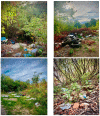Microplastics: A Real Global Threat for Environment and Food Safety: A State of the Art Review
- PMID: 36771324
- PMCID: PMC9920460
- DOI: 10.3390/nu15030617
Microplastics: A Real Global Threat for Environment and Food Safety: A State of the Art Review
Abstract
Microplastics are small plastic particles that come from the degradation of plastics, ubiquitous in nature and therefore affect both wildlife and humans. They have been detected in many marine species, but also in drinking water and in numerous foods, such as salt, honey and marine organisms. Exposure to microplastics can also occur through inhaled air. Data from animal studies have shown that once absorbed, plastic micro- and nanoparticles can distribute to the liver, spleen, heart, lungs, thymus, reproductive organs, kidneys and even the brain (crosses the blood-brain barrier). In addition, microplastics are transport operators of persistent organic pollutants or heavy metals from invertebrate organisms to other higher trophic levels. After ingestion, the additives and monomers in their composition can interfere with important biological processes in the human body and can cause disruption of the endocrine, immune system; can have a negative impact on mobility, reproduction and development; and can cause carcinogenesis. The pandemic caused by COVID-19 has affected not only human health and national economies but also the environment, due to the large volume of waste in the form of discarded personal protective equipment. The remarkable increase in global use of face masks, which mainly contain polypropylene, and poor waste management have led to worsening microplastic pollution, and the long-term consequences can be extremely devastating if urgent action is not taken.
Keywords: biodegradable materials; ecotoxicity; food safety; plastic pollution; plastic waste; public health; sources of microplastics.
Conflict of interest statement
The authors declare no conflict of interest.
Figures








References
Publication types
MeSH terms
Substances
LinkOut - more resources
Full Text Sources
Medical

